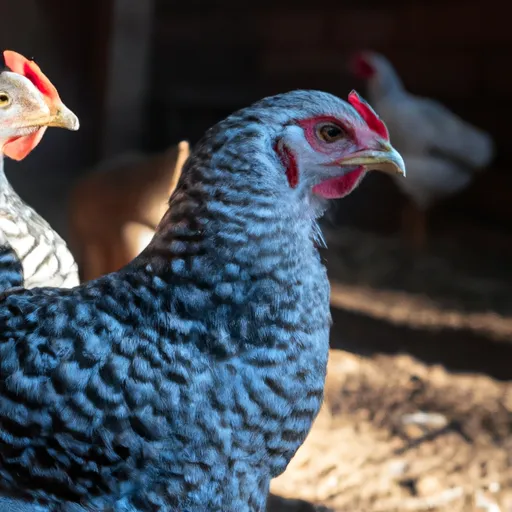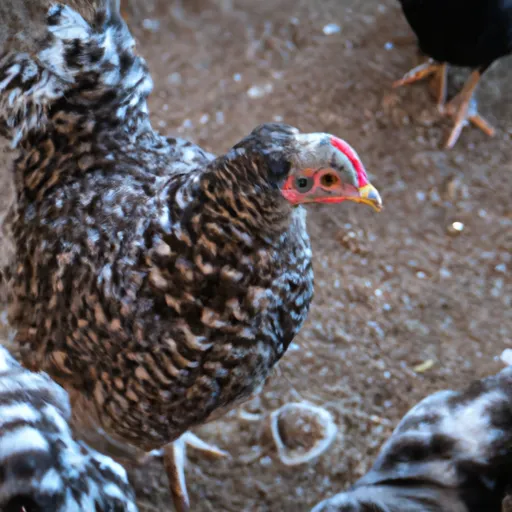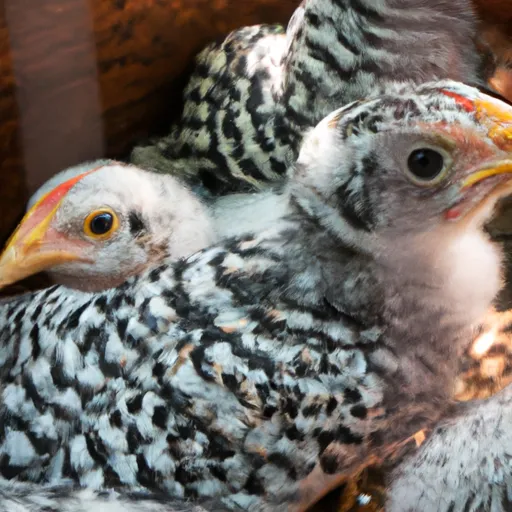Raising Barred Rock Pullets: A Beginner’s Guide
Are you a beginner looking to raise barred rock pullets?
Look no further! This comprehensive guide will walk you through the basics of raising these delightful birds.
From selecting the right breed to providing proper nutrition and housing, we have got you covered.
Whether you are an aspiring homesteader or simply want to add some feathered friends to your backyard, this article will give you the knowledge and confidence to successfully raise barred rock pullets.
Get ready to embark on an exciting journey filled with fluffy chicks, bustling henhouses, and delicious farm-fresh eggs!
Choosing Barred Rock Pullets
Researching Different Breeds
When it comes to selecting the right breed of pullets for your flock, it's essential to do your research. Barred Rock pullets are a popular choice for many reasons.
They are known for their friendly nature, high egg production, and beautiful black and white striped feathers.
Take the time to learn about other breeds as well to determine which one aligns with your goals and preferences.
Identifying Barred Rock Pullets
Identifying Barred Rock pullets is relatively straightforward. As chicks, they have distinct black and white stripes with yellow bellies.
As they mature, their feathers will become more defined, showcasing the classic barred pattern. Additionally, their size will increase, and they will develop the trademark red comb and wattles.
Look for healthy pullets with bright eyes, clean feathers, and sturdy legs.
Purchasing Barred Rock Pullets
Once you have decided that Barred Rock pullets are the right fit for your flock, it's time to purchase them.
There are various options available, including local breeders, hatcheries, or even online marketplaces. It's important to choose a reputable source to ensure the health and quality of the pullets.

Consider factors such as vaccination records, breeder reputation, and transportation logistics when making your decision.
Setting up the Coop
Choosing the Right Coop Size
A comfortable and spacious coop is vital for the well-being and happiness of your Barred Rock pullets. The general rule of thumb is to provide at least 4 square feet of space per bird inside the coop and 8-10 square feet in the outdoor run.
This allows for sufficient mobility and prevents overcrowding. Remember that adequate space helps reduce stress, aggression, and the risk of disease transmission.
Providing Sufficient Ventilation
Proper airflow is crucial for maintaining a healthy coop environment.
Barred Rock pullets, like all chickens, release moisture through their breathing, droppings, and feathers. Inadequate ventilation can result in high humidity levels, leading to respiratory issues and increased bacterial growth.
Ensure that your coop has adequate vents and openings to allow for proper air circulation without causing drafts.
Setting up Nesting Boxes
Nesting boxes are where your Barred Rock pullets will lay their eggs, so it's essential to provide comfortable and secure options.
The general recommendation is to have one nesting box for every 3-4 hens. Each box should be approximately 12x12 inches in size and filled with clean straw or shavings.
Place them in a quiet and dark corner of the coop to provide a sense of privacy and encourage egg-laying.
Preparing for Arrival
Creating a Brooder Area
Before your Barred Rock pullets arrive, you'll need to set up a brooder area to provide them a safe and controlled environment.
A brooder can be a large cardboard box or a specially designed brooder box or cage. Line the bottom with pine shavings or paper towels for easy cleaning. Ensure the brooder is draft-free, well-lit, and has enough space for the pullets to move around comfortably.
Managing Temperature and Lighting
Maintaining the right temperature is crucial during the first weeks of the pullets' lives.
For the first week, the brooder temperature should be around 95°F (35°C) and then gradually decreased by 5°F (2.8°C) each week until reaching ambient temperature. Provide a heat source such as a heat lamp or brooder heater.
Additionally, provide a consistent light source for newborn pullets, usually 24 hours a day, gradually reducing it to 14-16 hours as they mature.
Ensuring Clean Water and Feeding
Clean water and proper nutrition are essential for the healthy development of your Barred Rock pullets. Use a shallow water container, such as a chick waterer, to prevent drowning accidents.
Ensure fresh water is available at all times and clean the container regularly. As for their diet, start with a high-quality chick starter feed with a protein content of around 18-20%. Gradually transition to a grower feed as they mature.
Caring for Barred Rock Pullets
Establishing a Feeding Schedule
Maintaining a regular feeding schedule is crucial to meeting the nutritional needs of your Barred Rock pullets.
Offer feed twice a day and remove any uneaten feed after 20-30 minutes to prevent spoilage or attracting pests. As they mature, transition to a layer feed with a protein content of 16-18% to support egg production.
Additionally, provide calcium supplementation in the form of crushed oyster shells or eggshells.
Monitoring Health and Hygiene
Regular health monitoring is essential to identify any potential issues with your Barred Rock pullets promptly.
Watch for signs of illness such as lethargy, appetite loss, abnormal droppings, or respiratory symptoms. Keep their living environment clean by regularly removing droppings, replacing bedding, and disinfecting the coop.
Conduct regular health checks, including examining their feathers, eyes, and feet for any abnormalities.
Regular Egg Collection
Barred Rock pullets are renowned for their egg-laying abilities. As they reach maturity, expect them to start laying eggs around 20-24 weeks of age.
Collect eggs at least once or twice daily to ensure freshness and prevent them from getting dirty or cracked. Regular egg collection also helps maintain good hygiene and reduces the likelihood of pullets developing a habit of eating their eggs.
Socializing Barred Rock Pullets
Introducing New Pullets to the Flock
Introducing new Barred Rock pullets to an existing flock should be done slowly and carefully to minimize stress and aggression.
Begin by gradually integrating them into the same space, but with physical barriers that allow visual contact. This helps the pullets get acquainted without direct confrontation.
After a few days, start supervised interactions, gradually increasing the duration until the new pullets are fully accepted by the existing flock.
Educating Pullets in the Pecking Order
hierarchy within the flock. It's essential to allow the Barred Rock pullets to establish their place in the order naturally.
Avoid interfering in minor squabbles or intervening excessively, as this disrupts the natural social dynamics.
Ensure there are sufficient resources (food, water, and space) for all pullets, reducing the likelihood of prolonged aggressive behavior.
Encouraging Interactions and Behaviors
To foster a friendly and social flock, encourage positive interactions and behaviors among your Barred Rock pullets.
Provide various toys, perches, and entertainment options to keep them mentally stimulated. Allow them free-range time in a safe and fenced area, encouraging natural foraging behaviors.
Spending time with your pullets, talking to them, and providing treats can also help build trust and strengthen the bond between you and your feathered friends.
Integrating Barred Rock Pullets with Other Breeds
Understanding Chicken Dynamics
Understanding chicken dynamics is crucial when integrating Barred Rock pullets with other breeds. Each breed may have different temperaments and personalities, which can influence how easily they integrate.
Monitor the interactions closely during the integration process, ensuring that there is no excessive aggression or bullying. Some breeds may integrate more smoothly than others, so be patient and prepared to make adjustments if necessary.
Gradual Introduction and Supervision
To successfully integrate Barred Rock pullets with other breeds, it's essential to take a gradual approach.
Begin by introducing the pullets to the established flock in a neutral territory, such as a separate run or a supervised free-range area.
Observe their interactions closely, looking for signs of aggression or excessive bullying. If needed, separate the pullets temporarily and reintroduce them once they are better accepted by the existing flock.
Addressing Potential Conflicts
Throughout the integration process, it is possible to encounter conflicts between the Barred Rock pullets and other breeds.
If aggression becomes an issue, consider providing additional food and water stations to reduce competition. Provide hiding spots or distractions within the coop to allow bullied pullets a chance to escape.
If conflicts persist or become severe, be prepared to separate aggressive individuals to ensure the safety and well-being of all birds.
Addressing Common Barred Rock Pullet Issues
Egg Laying Problems
Barred Rock pullets are generally excellent layers, but occasionally, issues may arise. Common egg laying problems include soft-shelled or shell-less eggs, egg binding, or a sudden decrease in egg production.
These issues can be caused by various factors, such as stress, poor nutrition, or certain diseases.
Ensure a balanced diet, provide sufficient calcium supplementation, and monitor for any signs of illness. If problems persist, consult a veterinarian for guidance.
Behavioral Issues
Barred Rock pullets, like any chickens, can occasionally exhibit behavioral issues. These may include feather picking, excessive pecking, or aggressive behavior.
Addressing behavioral issues requires identifying the underlying cause and implementing appropriate solutions. Factors such as overcrowding, boredom, or nutritional deficiencies can contribute to these issues.
Provide ample space, environmental enrichment, and a well-balanced diet to promote positive behaviors.
Health Concerns
Maintaining the health of your Barred Rock pullets is of utmost importance.
Be vigilant for signs of common health concerns such as respiratory infections, parasites, or reproductive disorders.
Regularly inspect their feathers, skin, eyes, and feet for any abnormalities. Implement a preventative healthcare routine that includes vaccinations, parasite control, and regular check-ups with a veterinarian. Promptly address any health concerns to ensure the well-being of your flock.

Barred Rock Pullet Breeding
Identifying Pullet Maturity
Breeding Barred Rock pullets should be done when they have reached maturity.
Pullets are generally considered mature around 5-6 months of age or when they start laying eggs. Observe their behavior and physical changes closely, such as the development of a larger comb, bright red wattles, and increased vocalization.
Ensure that the pullets are in optimal health and have reached the appropriate age before initiating the breeding process.
Choosing Suitable Breeding Stock
Selecting suitable breeding stock is essential for maintaining the desired traits and characteristics of Barred Rock pullets.
Choose pullets that exemplify the breed's standard, with strong body conformation, healthy feathers, and good egg production.
Select a rooster that complements the desired traits and is from a healthy and vigorous bloodline. Avoid breeding closely related individuals to minimize the risk of genetic disorders.
Managing the Breeding Process
When breeding Barred Rock pullets, it's important to manage the process carefully to ensure successful reproduction.
Provide a separate breeding area, such as a designated pen or enclosure, where the chosen rooster and pullets can interact undisturbed. Monitor mating behaviors and ensure that the eggs are being properly fertilized.
Provide a comfortable and secure nesting area for the pullets to lay their eggs, collecting and storing them appropriately for incubation or brooding.
Preparing Barred Rock Pullets for Winter
Adjusting Diet and Nutrition for Cold Weather
As winter approaches, it's crucial to adjust the diet and nutrition of your Barred Rock pullets to help them cope with the cold temperatures. Increase their caloric intake by offering higher-energy feeds or increasing the amount of their regular feed.
Consider adding supplements such as cracked corn or black oil sunflower seeds to provide extra calories and help maintain body heat. Ensure access to clean, unfrozen water at all times.
Providing Adequate Shelter and Protection
Creating a suitable shelter is essential for protecting your Barred Rock pullets from the harsh winter elements. Insulate the coop with appropriate materials to prevent drafts and keep it dry.
Provide roosting bars at different heights, allowing them to huddle together for warmth. Consider adding bedding, such as straw or wood shavings, to provide extra insulation. Regularly check for any potential leaks or vulnerabilities that may compromise their comfort and safety.
Implementing Winter Maintenance
Regular maintenance is necessary to keep the coop in optimal condition during the winter months. Clear any snow, ice, or debris from the coop entrance and pathways to prevent slipping or blockage.
Check for signs of condensation or excessive moisture, as this can lead to frostbite or respiratory issues. Inspect and repair any damaged parts of the coop promptly.
Provide additional bedding as needed to keep the pullets comfortable and protected from the cold.
Barred Rock Pullet Predators
Common Predators to Watch Out For
Barred Rock pullets are appealing to various predators, so it's essential to be aware of potential threats.
Common predators include raccoons, foxes, coyotes, rats, snakes, and birds of prey. These predators may target your pullets for their eggs, meat, or simply as easy prey.
Regularly inspect the coop and fencing for any vulnerabilities and reinforce them to prevent unauthorized access. Implement predator-proofing measures such as securing the coop with sturdy locks and burying wire mesh around its perimeter.

Implementing Predator Prevention Measures

To protect your Barred Rock pullets from predators, it's crucial to implement
preventative measures. Install hardware cloth or predator-proof wire mesh to secure the coop and run, ensuring that there are no gaps or weak spots.
Consider adding motion-activated lights or alarms to deter nocturnal predators. At night, securely lock the coop to prevent predators from gaining entry.
Regularly inspect the surrounding areas for signs of predators and take appropriate action if necessary.
Creating a Secure Environment
Creating a secure environment is crucial for the safety and well-being of your Barred Rock pullets.
Ensure that the coop is sturdy and well-maintained, with no loose or rotting parts. Regularly check for potential entry points, such as holes in the fencing or gaps in the coop walls.
Provide an enclosed run with a solid roof to prevent aerial attacks. Consider using predator deterrents such as scarecrows or reflective items to discourage unwanted visitors from approaching the coop.
